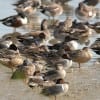 by Jim Stevenson
by Jim Stevenson
Dabbling ducks are fresh water varieties, vegetarians and their resulting light weight allows them to jump straight up off the water and take flight. They are the targets of hunters, as their meat is delectable (not the diving ducks). They range in size from teal (two species toward the front) to the large, Gadwalls, shovelers and wigeons you see toward the back. They feed on the surface, although they often stick their heads underwater, but never dive.
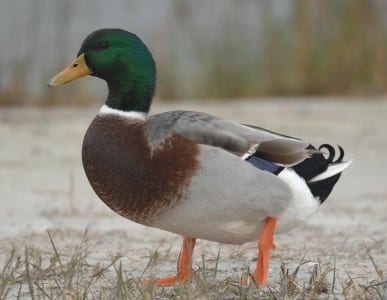
Mallards are the most familiar of the group we call dabbling ducks, or puddle ducks. This is a typical male Mallard, with the green head acting as a ruptive mark. These break up the form of this bird, and many birds, snakes and other animals have ruptive marks. Mallards often interbreed with other species and leave telltale signs like the curly tail on their children.
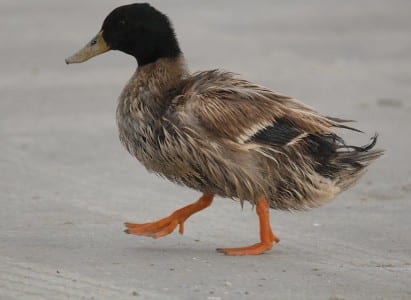
This male Mallard obviously has a problem, the avian “bad hair day.” I suspect he isn’t molting and is stuck with yesterday’s feathers. Were he living in colder climates, where most Mallards winter, he would likely be a goner. But in Rockport his chances are enhanced. Note the white bars on the speculum.
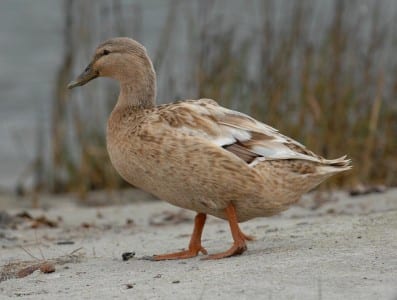
Not to be outdone, this female Mallard is leucosistic, or partially albino. Or maybe her daddy married some white cat (by that I mean a white Muscovy). Honestly, it’s hard sometimes to know how semi-domestic birds get their colors. But she walks like a Mallard, quacks like a Mallard, so she’s mostly Mallard.
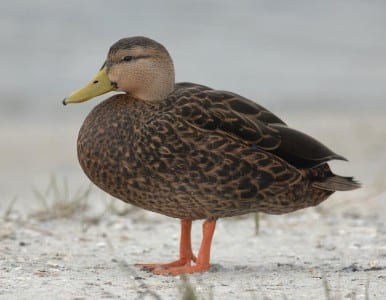
Closely related to Mallards are Black and Mottled Ducks, this one being the latter. Males are slightly larger and darker than hens with a pea-green bill. Pure Mottled Ducks have a purple speculum with no white border, but the slightest bit of Mallard blood in them (and they DO hybridize) whitens the borders of the speculum. Can you see the purple?
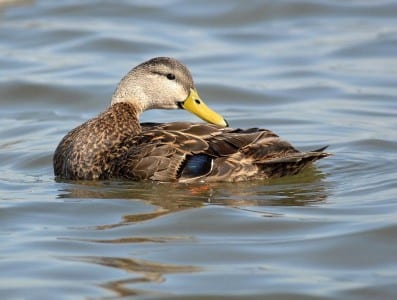
This preening male Mottled Duck also seems to be a fairly pure-blooded specimen. Ducks, and most waterbirds, spend a lot of time preening, as there is high food availability. They just don’t have to forage a lot. Mottled Ducks are one of the few ducks that almost lack sexual dimorphism, somewhat like the similar Mexican Duck.
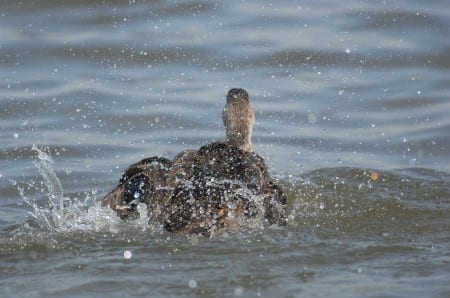
Ducks also spend a lot of time bathing, and this one looks like my old Labrador puppy splashing in the tub when bathed. If you look at the speculum, though, you can also see it lacks any white on the speculum border. It’s nice to see so many pure-blooded Mottled Ducks!
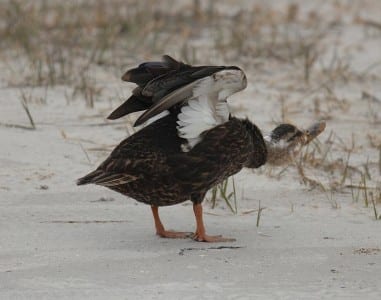
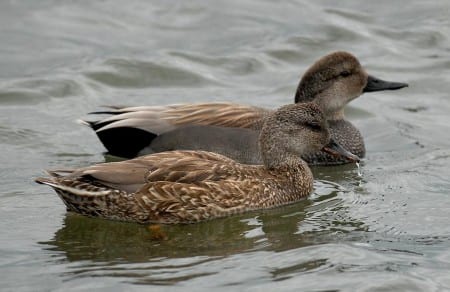
Also pretty closely-related to Mallards are Gadwall, the “gray duck with a black butt.” Females usually have the orange bill but both show the black and white specula in flight that’s very diagnostic (see next photo). I also like the soft-colored scapulars covering the top of the wings.
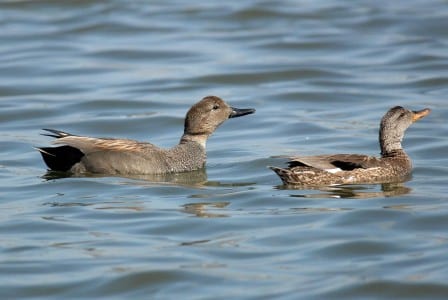
Many ducks start thinking about reproDUCtion on their wintering grounds. I believe these two are showing an interest in each other. Some ducks mate on their wintering grounds, as some males don’t make the trip back. I think she’s playing hard to get. Note the difference between the bill color on this female and the last page.
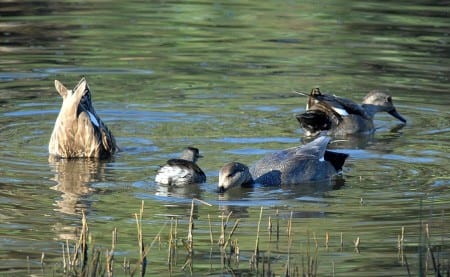
This flock of Gadwalls are dabbling and tipping up, bringing on the name of their group. Those dabbling are feeding on emergent vegetation and those tipping up are munching on submergent vegetation. It would be very hard for them to actually dive, as buoyant as they are. OK, can you identify the second bird from the left? I know, I know; it’s a tough angle. I’ll ID it at the end of the article.
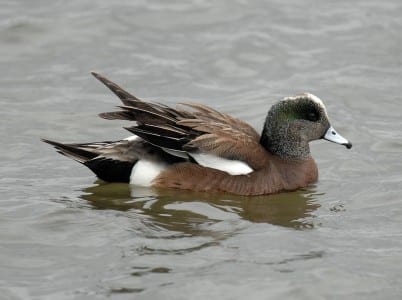
Less related to the Mallard are the wigeons, several species of dabbling ducks found around the World. This is the American Wigeon, formerly called a Baldpate (for the white cap). As you can tell from the wing, these have a huge patch of white on the leading edge of the wing, not unlike the blue on some teal (and shovelers). You can see the white in flight (white flight?) many hundreds of yards off. Wigeons have short bills with sharp lamellae for clipping off grass and other vegetation. They are often seen on land in grassy areas.

Another group of dabbling ducks are the pintail. This “greyhound” is the Northern Pintail, as it (and Northern Shovelers) nests all the way to the Arctic Ocean. Their soft colors and elegant shape makes them among our loveliest ducks, and they and shovelers can out-fly all other ducks.

There is a lesson here in this preening bird. Do you see how different the wing looks from the male in the last shot? It is almost proverbial that birders compare a bird in the field to the field guide and it doesn’t look the same! Much depends on the angle, light and other factors of the bird under study. Don’t you like that bill?
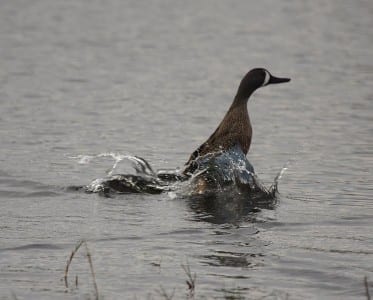
Dabbling ducks pop off the water almost instantly, due to their light weight and method of take-off. They actually slap the water with their wings to break the surface tension and off they go! This Blue-winged Teal male has saber-like wings and they also fly like bloody murder. The more narrow wings make them have to slap the water harder than ducks with wider wings, which can achieve lift easier. BTW, they have been clocked close to 70 mph, like me on Galveston’s Seawall.
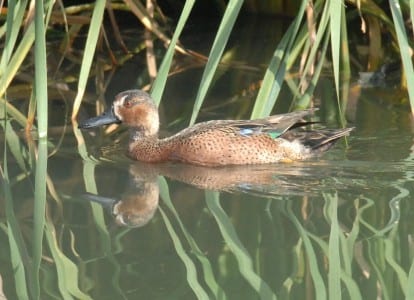
Lastly, a special treat: a hybrid! This male’s parents were Blue-winged and Cinnamon Teal. He is largely the color of the Cinnamon but has the white facial arch of the BW. The two species have similar wings, and you can see both the green speculum and the blue on the leading edge of the wing. How cool is that? So Cinnamon and Blue-winged Teal are both beautiful, with many great similarities and some uniqueness as well. Blending the two only makes for a more beautiful bird, like a good marriage. 😉 The tiny bird swimming with the Gadwalls was a Least Grebe.

 Posted in
Posted in 























